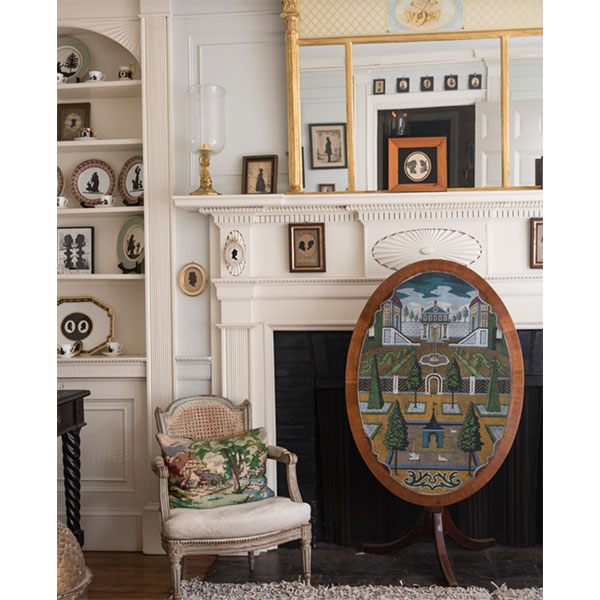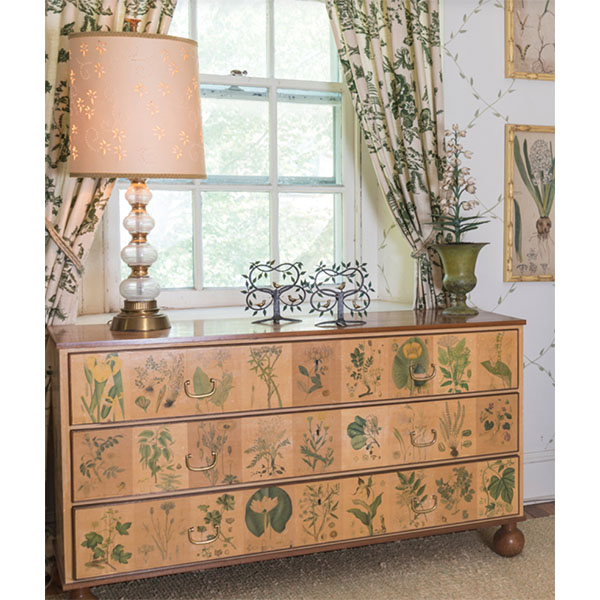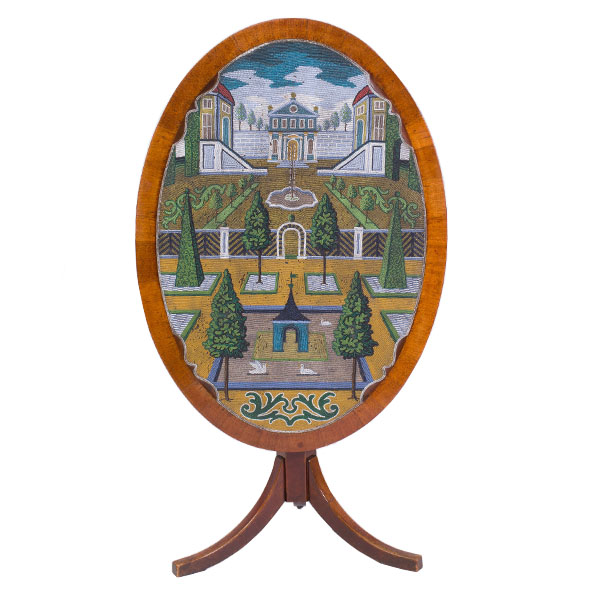The Collection of Mrs. John Gutfreund – Murray House, Villanova, Pennsylvania
- 20th Century Design
- american antiques
- American Art
- American furniture
- Interior Design
- Stair Galleries
Rag rugs rarely come to mind when the conversation turns to Susan Gutfreund, society swan, philanthropist, and interior decorator. After all, her legendary residences—apartments in River House and 834 Fifth Avenue in New York City and in Hôtel d’Orrouer in Paris—have been transformed by the gilt-wood touch of grand homme Henri Samuel and also the assessing eye of her friend Hubert de Givenchy. Her winter-garden-style sitting room overlooking Fifth Avenue and Central Park, designed by Samuel, remains one of the 20th century’s most staggeringly beautiful spaces, a romantic, fondant-colored Belle Époque fantasia of chinoiserie, trelliswork, and lush, button-tufted 19th-century seating, all set to the chirping of caged love birds beneath a domed ceiling.

In the Pennsylvania countryside, not far from Villanova, though, Gutfreund took the opportunity to break free of that formalist, Europhile vocabulary. Murray House was the Federal Style, magnolia-embowered stone farmhouse that she and her late husband—John H. Gutfreund, a former chairman of Salomon Brothers known as “the King of Wall Street”—leased and restored and where they spent weekends for close to twenty years. It is one of several old houses and cottages on the high-flying Scott family’s exquisite Ardrossan Estate (“living anywhere on Ardrossan is like having a summer share in heaven,” a visitor once observed), and there Gutfreund conjured up highly personal rooms that seemed to have developed quite by happenstance, where periods and modes met in surprising juxtapositions amid inviting rooms where every comfort was to hand.
Given the close proximity of the Scotts’ grand main house, as well as painterly views of rolling fields, hay bales, and lowing cattle, Gutfreund imagined Murray House as the bolthole of, say, an aristocratic family’s younger son or grandson, to whom had funneled a variety of treasures high and low and then blended them together into dégagé settings of color, ease, and charm. “It was a hodgepodge of the mismatched, where important things didn’t look important,” she explains of the laidback, Anglo-American effect, where flowered chintz curtains from England’s Elveden Hall (seat of the Earl of Iveagh) could share a room with an embroidered Robert Kime chair and adjacent to what she calls “an attractive nothing made of wicker.”

Silhouettes fashioned in England, Scandinavia, and the United States from the 18th to the 20th centuries transformed a pale gray sitting room into a portrait gallery out of a Jane Austen novel, joined by antique French porcelains ornamented with matching profiles. Sprightly Scandinavian Modern furniture by the 1940s tastemaker Josef Frank—the drawers and doors collaged with botanical motifs—furnished one of the eight sunny bedrooms, where it was set against walls stenciled with pale green trelliswork that Gutfreund adapted from a decorative effect she saw at a Philadelphia Museum of Arts exhibition. In a corridor an 18th-century Swedish tall-case clock met, of all things, a contemporary leather-and-straw Tuareg mat that was woven in Mauritania.
Lot 8, Josef Frank, "Flora" Printed Paper and Mahogany Chest of Drawers; Estimate $15,000-$30,000
Connoisseurs were surprised to see a scattering of 18th Century German tables (rarities that may well be the finest in private American hands) surfaced with glass beadwork scenes that depict gardens, fountains, and flowers. The entrance hall sports a great collage of pressed leaves by artist Stuart Thornton—his clients include Marella Agnelli, for whom he long served as a majordomo—and elsewhere the Gutfreunds displayed tempera-on-vellum still lifes by 17th-century artist Octavanius Monfort.
Lot 1, William Stuart Thornton, Gunnera Chilengsis; Estimate $2,000-$4,000
If the decor of Murray House had a “Rosebud” moment, an aesthetic key, it probably stood in the corner of the red living room, and Susan Gutfreund has described it as “the first vintage piece I ever bought, in 1971: a big 1940s table with a mirrored frieze and a black-lacquer chinoiserie top.” Though far from exalted in its origins and surely a startling to find inside a Federal Style house in Pennsylvania hunt country, the generously scaled table’s orientalist flair is an early inkling of Gutfreund’s appreciation for the exotic and the luxurious, hinting at the intriguing, rafinée rooms to come, whether they were conjured up in association with Henri Samuel or executed all on her own.
The catalogue for The Collection of Mrs. John Gutfreund will be online on March 1, 2019.
By STAIR
Copyright © 1999 - 2025 STAIR. All Rights Reserved.
- Celebrate American Heritage with Dana Auctions’ January 25 Antique and Vintage Quilt and Textile Auction
- Exciting Online Auction from Rafael Osona Auctions - Exceptional offerings across multiple categories
- DIAMONDS ARE FOREVER: FINE JEWELRY, DIAMONDS & MORE COME TO TURNER AUCTIONS + APPRAISALS
- TAKE TIME OUT TO VIEW SPORTS MEMORABILIA, COMING TO TURNER AUCTIONS + APPRAISALS ON AUGUST 17
- Rafael Osona Announces Two Day Auction, Aug 3 & 4, 2024 Americana, Fine Arts, Historic Nantucket, Décor ~ Saturday, August 3 The Marine Session ~ Sunday, August 4 Open for Bidding ~ 1000 Lots ~
- Kobe Photomatched Final Game Worn Warm-Up Takes the Stage in SCP’s Summer Premier Auction
- BOHEMIAN CLUB & BOHEMIAN GROVE POSTERS, BOOKS & EPHEMERA COME TO TURNER AUCTIONS + APPRAISALS ON AUGUST 10
- Rafael Osona's Early Summer Auction Gallery Preview July 3,4,5 Auction July 6 - 700 lots
- CARMEL ESTATE AUCTION FEATURES DIVERSE ARTWORKS, DECORATIVE ARTS & MORE AT TURNER AUCTIONS + APPRAISALS
- TRADITIONAL & CONTEMPORARY JAPANESE PRINTS COME TO AUCTION ON JUNE 22 AT TURNER AUCTIONS + APPRAISALS
-
Antique Toy Auction at Pook & Pook Inc, with Noel Barrett

-
Sporting Immortality

-
The Collection of Mrs. John Gutfreund – Murray House, Villanova, Pennsylvania

-
Leonora Carrington Oil Painting Sells for More Than Twice the Asking Price in the Latin American Art Auction Hosted by Morton Subastas in Mexico City

-
Peter Tillou Collection Highlights Litchfield Auctions’ 25th Anniversary




 EUR
EUR CAD
CAD AUD
AUD GBP
GBP MXN
MXN HKD
HKD CNY
CNY MYR
MYR SEK
SEK SGD
SGD CHF
CHF THB
THB

.jpg)

